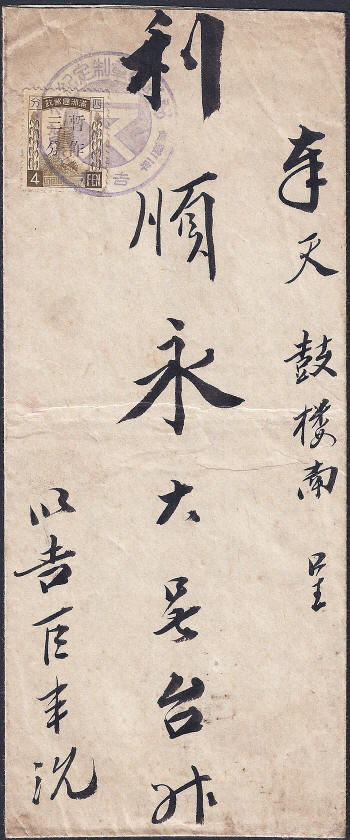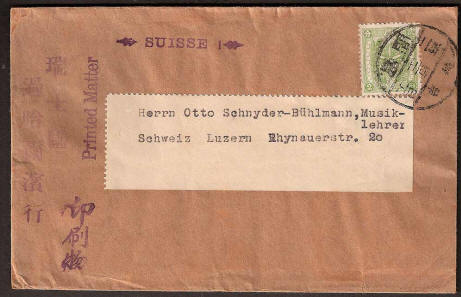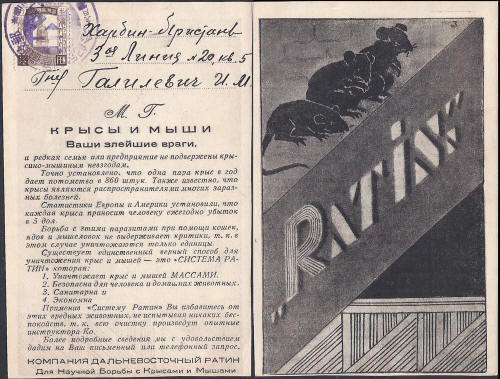 |
|||||
|
|
|
1935 Covers & Postal History Manchukuo Year 2 康德 Kāngdé
|
|||
|
Domestic Cover Kirin to Fengtien The commemorative postmark shows that this cover entered the postal system of 18th September 1935. The stamp value is 3f and this is correct for this period. The overprint on the 4f stamp reads "3f Temporary Use" this rate was in force from 1st March 1934 until 31st March 1937, initially there was a shortage of 3f stamps.
Yenki Mission Printed Matter Cover This shows a 2f Second China Mail stamp used on a "Printed Matter" cover sent from the Catholic Mission in Yenki to a music teacher in Lucerne, in Switzerland, dated 11th March 1935.
|
|||||
|
Local Commercial Postcard - Printed Matter? This is a front and back view of an advertising postcard sent by a pest control company in Harbin. Apart from the social history interest this card also raises some questions about postage rates. The card entered the postal system on 20th September 1935 and would have been a local item. A local rate postcard at this time would have required postage of 1f but this postcard only has one ½f stamp. This probably indicates that this was the local charge for printed matter and if so this rate would have been introduced from 1st march 1934, or before. Previously the earliest item of local printed matter I have found dates from 1936 so this card has caused me to revise the schedule of domestic postage rates.
|
|||||
|
|
|||||
| Reply Paid Postcard | |||||
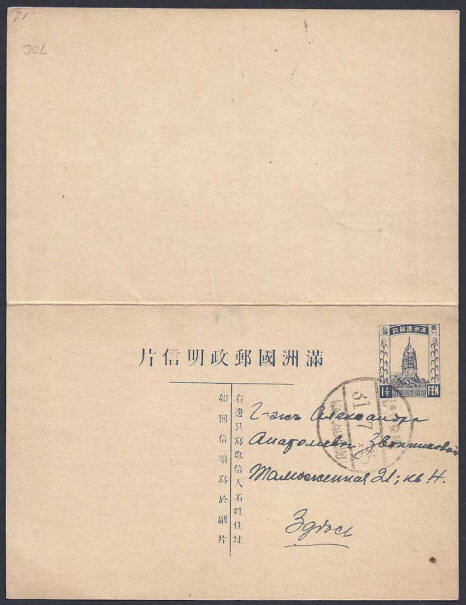 |
|||||
|
This is a reply paid postcard of which
only one section has been used. The card was addressed to Alexandra
Zvonikova at Tamozhennaya 21-4 what looks like a town name is ЗДeСЬ
meaning here, presumably Harbin. The message concerns books being dropped off
and forwarded to others. The recipient did not use it to reply, such cards are
scarce. The reverse of the card can be seen
here. Alexandra Zvonnikova was the wife of a lawyer Alexandr Zvonnikov. Her family emigrated for Russia in the early 1920's and she lived in China, Brazil and Australia. In 1982 she received a card from Her Majesty Queen Elizabeth II of England to congratulate her on her 100th birthday. The card has an international postmark from Harbin and the postage rate of 1½f was the correct domestic postcard rate at this time. As the card seems to have been used within Harbin it may have been possible for the sender to have used a 1f + 1f card instead and taken advantage of the Intra-City rate. |
|||||
|
|
|||||
| Cover with Registration Slip Attached | |||||
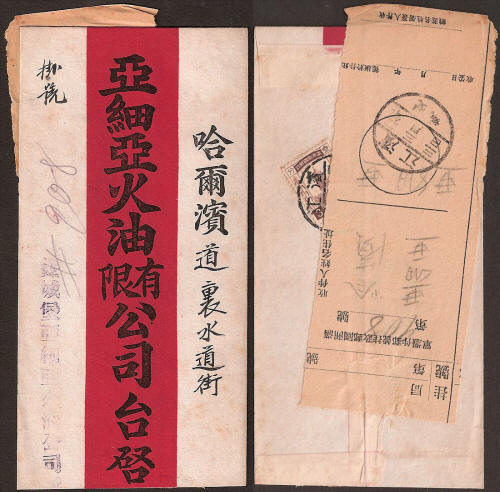 |
|||||
|
This is a registered cover that has retained its registration slip. Torn off remnants of these slips are often found but it is unusual to find a slip that is complete. The cover was sent to 亞細亞火油有限公司台 Asia Oil Company Limited, in Harbin by 城堡亞細亞火油公司 ? Castle Oil Corporation Asia. The cover was sent on 3rd March 1935 and carries an old style 滨江 Pin Kiang (Bin Jiang), Harbin postmark. The postage was 9f made up of 3 x 3f stamps, 3f letter rate + 6f for registration, correct for this date. The postman left this letter with registration slip is unsigned. |
|||||
|
|
|||||
| International Cover from Mukden I.N.P.O. to London, England | |||||
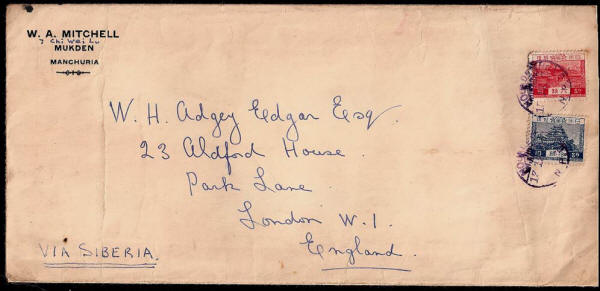 |
|||||
|
This oversize cover was sent on 17th
December 1935 from Mukden I.N.P.O. to
Capt W. H. Adgey Edgar in London.
There is no arrival date-stamp and so the transit time is unknown.
The rate shown is the Japanese 10s (20g) letter rate + 6s for an additional 20g. There was no advantage gained by sending this letter from the Japanese Post Office in Mukden as costs were identical at this time. |
|||||
|
|
|||||
| Card with Scenic and Commemorative Cancels | |||||
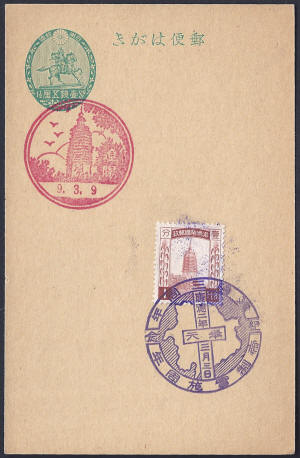 |
|||||
|
This is an unusual card because it
combines cancels from different post offices in different towns on
different dates.
This card is purely a philatelic item and it started out at the SMRZ post office in 遼陽 Liao yang where it received the upper "scenic" cancel showing the white pagoda. This cancel uses the Japanese 昭和 Shōwa year date and was issued on 9th March 1934. Nearly a year later the card was taken to a Manchukoan post office in Mukden where the 1f stamp was added and cancelled. This lower cancel is dated 3rd March 1935, and reads 建國三周年並帝政實施周年紀念 Commemorating the Third Anniversary of the Founding of the State and the First Anniversary of the Establishment of Imperial Government. |
|||||
|
|
|||||
| Japanese Military Mail Sent Through (SMRZ) Field Post Offices | |||||
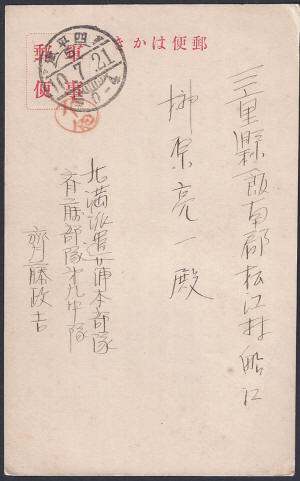
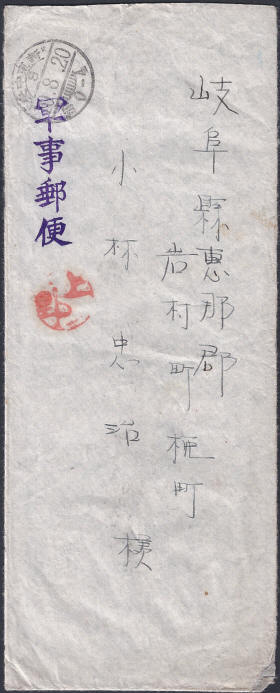 |
|||||
|
The card was posted from
四平台
Szepingkai (now
Siping) Field Office 5 on 21st July 1935 and the letter went through
the Field Post Office 9 based at 新京中央
Hsinking Central
Post Office on 20th August 1935. Both the card and the cover are
addressed to Japan. To see the reverse of the card click here, to see the reverse of the letter cover here. More information about this post is shown here. |
|||||
|
|
|||||
| Defaced First China Mail Covers | |||||
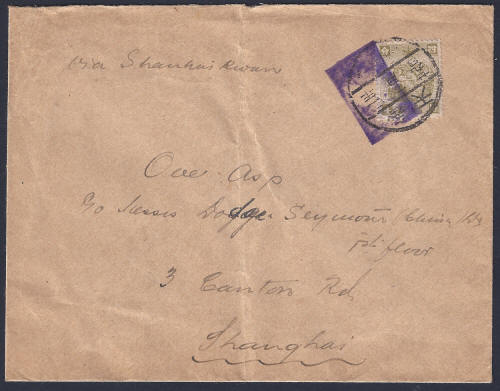 |
|||||
|
This is an example of the use of an
"obliterator" almost identical to the example shown is in Helen K,
Zirkle's book "The Postage Stamps and Commemorative
Cancellations of Manchoukuo" (page 18). In this instance the
obliterator is used, ineffectively, to hide the Manchukoan year
date. The letter was sent from Mukden on 25th January 1935 the transit time to Shanghai is unknown because there is no arrival date-stamp. The postage of 4f was correct. The back of the envelope shows the logo of the Asiatic Petroleum Co Ltd., |
|||||
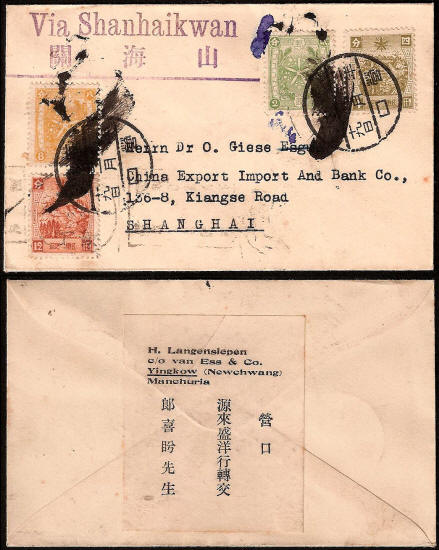 |
|||||
|
This is a cover posted from a
company in
營口
Yingkou (see label) to the China Export Import &
Bank Co in Shanghai (not to be confused with the modern Export
Import Bank of China which was founded in 1994). The sender has
added a via
山海關
Shan-hai-kuan
handstamp. This was unnecessary as there were no other sensible
routes it might have taken. The date of posting was 19th February 1935 as shown by the date stamps. These date stamps have been defaced by black ink applied by a brush, this was because they carried the Manchukuoan year date for 1935. Could it be that the obliterators worked so poorly they resorted to ink? The cover is a philatelic item, the empty envelope is still sealed and carries one each of the first issue China Mail stamps. The correct postage for this item would have been 4f and not the 26f of stamps applied. The cover has a feint arrival postmark for Shanghai but this is unreadable. |
|||||
|
|
|||||

